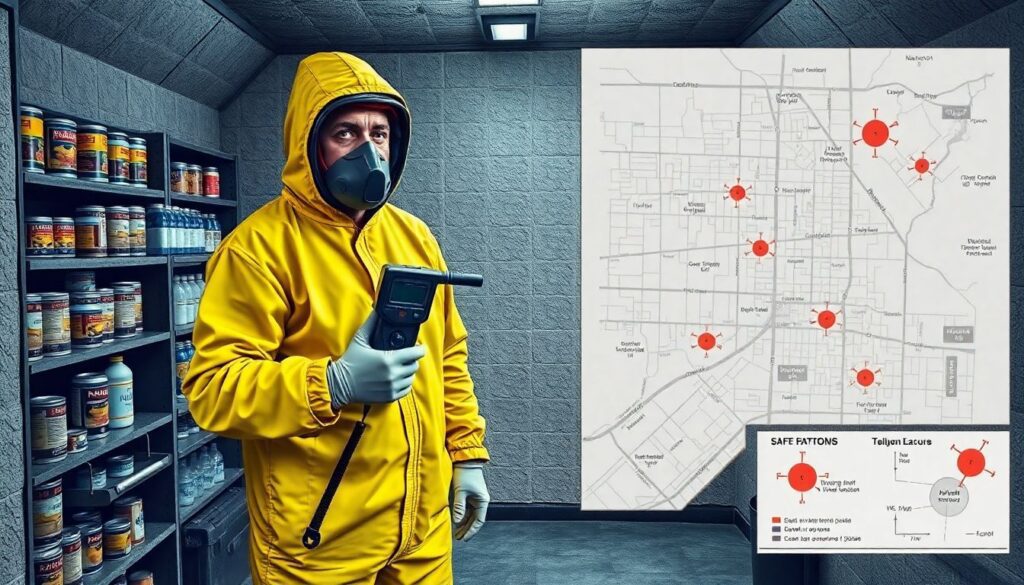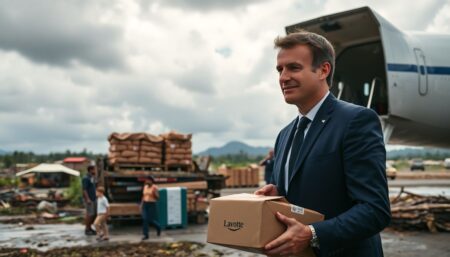Have you ever wondered how you would fare in the face of an unimaginable catastrophe, such as a nuclear fallout? The thought might send shivers down your spine, but it’s a reality that we must prepare for, no matter how unlikely it may seem. This article, ‘The Prepper’s Guide to Surviving a Nuclear Fallout’, is here to empower you with the knowledge and strategies you need to navigate such a daunting scenario. By the end of this comprehensive guide, you will not only understand the science behind nuclear fallout and radiation, but also gain practical insights into radiation protection and post-nuclear preparedness.
Let’s start with a sobering fact: according to the Nuclear Threat Initiative, as of 2021, there are approximately 13,000 nuclear weapons in the world, with around 1,800 of them being strategically deployed and ready for use. While the likelihood of a nuclear attack is thankfully low, it’s a risk we cannot afford to ignore. So, the question is, are you ready to face the unthinkable? If not, you’re in the right place. This guide promises to equip you with the tools and information you need to increase your chances of survival and resilience in the event of a nuclear fallout.
Agreeably, the prospect of a nuclear fallout is terrifying. The immediate blast, the heat, and the radiation that follows can seem insurmountable. But here’s where we disagree with fear: while it’s important to acknowledge the danger, we must also recognize that preparation and knowledge can significantly enhance our chances of survival. This guide will not only demystify the science behind nuclear fallout but also provide practical steps for radiation protection and post-nuclear preparedness.
So, what can you expect to gain from this article? You will learn about the different types of radiation, their effects, and how to protect yourself from them. We will delve into the importance of sheltering in place, the art of water purification, and the role of a well-stocked pantry in a post-nuclear world. We will also explore the psychological aspects of surviving a nuclear fallout, because let’s face it, the mental challenge can be just as daunting as the physical one.
In essence, this guide is not about instilling fear, but about empowering you with the knowledge and skills you need to face any challenge that comes your way. It’s about turning a potential nightmare into a manageable situation, one step at a time. So, are you ready to take the first step towards preparedness? Let’s dive in.
Mastering Post-Nuclear Preparedness: A Comprehensive Guide to Nuclear Fallout Survival and Radiation Protection
In the face of an uncertain world, the specter of nuclear fallout looms as a chilling reminder of our vulnerability. However, it’s not a topic to be feared, but understood and prepared for. ‘Mastering Post-Nuclear Preparedness’ is your comprehensive guide to navigating the uncharted waters of nuclear fallout survival and radiation protection. Imagine you’re a modern-day Robinson Crusoe, stranded in a world reshaped by nuclear events. This isn’t about doomsday prophecies, but practical knowledge that could one day save your life. We’ll delve into the science behind radiation, debunking myths and misconceptions. You’ll learn to read the wind, calculate fallout patterns, and create makeshift shelters. We’ll explore the art of scavenging, finding and purifying water, and growing food in harsh conditions. But it’s not all about survival; we’ll also discuss the psychological aspects, ensuring you’re not just physically, but mentally prepared. Think of it as a lighthouse in the storm, guiding you through the darkness with clear, concise, and actionable advice. So, let’s roll up our sleeves, put on our thinking caps, and dive into the fascinating, if somewhat sobering, world of post-nuclear preparedness.
Understanding Nuclear Fallout
Nuclear fallout, a grim byproduct of nuclear explosions and reactor meltdowns, is a complex phenomenon that requires a deep dive into the science behind it. Fallout is essentially a mixture of radioactive particles and debris that is propelled into the atmosphere during a nuclear event. The formation of fallout is a multi-step process. First, the intense heat and blast wave of a nuclear explosion vaporize and pulverize materials, including soil, buildings, and even the bomb itself. These materials then become contaminated with radioactive isotopes, primarily from the fission process. As the cloud of debris cools, it condenses and forms tiny, invisible particles that can remain suspended in the atmosphere for extended periods.
The behavior of nuclear fallout in the atmosphere is influenced by several factors. Wind patterns play a significant role in dispersing fallout over vast areas. The height at which the fallout is released also affects its spread. Fallout released at higher altitudes can travel farther and wider before settling, while lower-altitude fallout may remain concentrated near the explosion site. Precipitation can also influence fallout patterns, as rain or snow can wash fallout out of the atmosphere and onto the ground.
It’s crucial to understand the difference between immediate radiation and residual radiation in the context of fallout. Immediate radiation, or prompt radiation, is released during the initial explosion and is deadly within seconds or minutes. Residual radiation, on the other hand, is the radiation emitted by the radioactive isotopes in the fallout after the explosion. This radiation can remain dangerous for hours, days, or even years, depending on the half-life of the isotopes involved. The most common isotopes in fallout are iodine-131, cesium-137, and strontium-90, all of which have relatively long half-lives.
The factors affecting fallout patterns are numerous and interconnected. They include the yield and height of the explosion, weather conditions, topography, and the composition of the terrain. Understanding these patterns is vital for predicting the spread of fallout and planning appropriate responses to nuclear events. However, it’s important to note that predicting fallout patterns with absolute certainty is impossible due to the complex and dynamic nature of atmospheric conditions.
In conclusion, nuclear fallout is a complex and dangerous phenomenon that requires a nuanced understanding of nuclear physics, atmospheric science, and meteorology. Its formation, behavior, and effects are influenced by a myriad of factors, making it a challenging and unpredictable hazard. Despite the challenges, understanding nuclear fallout is crucial for mitigating its effects and ensuring the safety of people and the environment in the event of a nuclear incident.
The Importance of Timing and Location
The timing and location of a nuclear explosion are critical factors that significantly influence the extent and severity of radioactive fallout, making them indispensable elements in preparedness planning. Let’s delve into the significance of these two aspects and explore how understanding them can enhance our readiness. The time of day plays a pivotal role in determining the distribution and intensity of fallout. A nuclear explosion at sunrise or sunset can result in fallout being carried by winds over a larger area due to the stable atmospheric conditions present at these times. Conversely, an explosion during midday or night might lead to fallout being concentrated in smaller areas due to unstable or calm winds respectively. Therefore, knowing the time of day an explosion occurs can help predict the likely spread of fallout and guide evacuation routes and safety measures. The location of a nuclear explosion is equally, if not more, important. The geography of the blast site can dictate the direction and speed of fallout travel. For instance, an explosion near a mountain range might result in fallout being trapped in valleys, while one over a large body of water could lead to fallout being carried by sea breezes. Urban areas, with their varied terrain and buildings, can also affect fallout distribution. Thus, understanding the topography and weather patterns of a potential blast site can aid in anticipating fallout paths and planning protective actions. To incorporate this information into preparedness planning, consider the following steps:
-
Understand Local Geography and Weather Patterns:
- Familiarize yourself with the terrain, wind patterns, and other weather conditions in your area to predict how fallout might travel.
Plan for Different Times of Day:
- Develop contingency plans for various times of the day, accounting for how wind patterns and fallout distribution might change.
Stay Informed:
- Keep up-to-date with official warnings and advisories, as they will provide real-time information about the time and location of an explosion, if one occurs.
Practice Evacuation Drills:
Regular drills can help you and your community become proficient in executing evacuation plans based on the time of day and location of a potential explosion.
By understanding and planning for the significance of timing and location, we can enhance our preparedness and response to nuclear incidents, ultimately helping to save lives and mitigate the impact of radioactive fallout.
Building a Fallout Shelter
Building a fallout shelter, a safe haven designed to protect against nuclear, biological, or chemical (NBC) threats, is a significant project that requires careful planning and execution. The first step in this process is selecting the right location. Ideally, you want a site that is below ground level, such as a basement or a hillside, to provide natural protection from radiation. The shelter should also be far enough from potential targets to avoid blast damage.
The design of your fallout shelter is crucial. It should be large enough to accommodate all occupants and their supplies, but small enough to heat and cool efficiently. A popular design is the ‘fallout room,’ a small, windowless room with a heavy door and minimal openings. This design provides maximum protection with minimal space.
When it comes to materials, concrete is your best friend. It provides excellent radiation shielding and is durable enough to withstand the force of a blast. Reinforced concrete is even better, as it can withstand more force. Steel doors and walls can also be used, but they should be lined with lead or other heavy materials to provide adequate shielding.
Ventilation and air filtration are critical components of any fallout shelter. Without proper ventilation, the air inside the shelter can become stale and toxic. With proper ventilation, you can bring in fresh air while keeping out radioactive particles. There are several types of air filtration systems available, from simple HEPA filters to complex systems that use activated carbon or other chemicals to remove toxins from the air.
To construct your fallout shelter, you’ll need to dig a trench or excavate a basement, then build your shelter using the materials you’ve chosen. This can be a complex process, so it’s important to consult with professionals and follow all local building codes. Once your shelter is built, you’ll need to stock it with supplies, including food, water, medical supplies, and entertainment. Regular maintenance and testing of your shelter and its systems is also crucial to ensure they’re ready when you need them.
Remember, the goal of a fallout shelter is not to make you comfortable, but to keep you alive. It’s a harsh environment, but with the right design and preparation, it can provide the protection you need in a crisis.
Stockpiling Essential Supplies
When preparing for an extended stay in a fallout shelter, it’s crucial to stockpile essential supplies that cater to your basic needs and ensure your safety and comfort. Let’s break down the key categories and items to consider.
Food and Water:
Your body’s primary fuel is food and water, so they should be your top priority. Aim for a variety of non-perishable, high-energy, and nutritious foods that require minimal preparation. Canned goods, dried fruits, nuts, and granola bars are excellent choices. Remember to rotate your stock to maintain freshness. As for water, store at least one gallon per person per day, and consider water purification tablets or a portable water filter for long-term use.
Medical Supplies:
A well-stocked medical kit is vital for treating injuries and illnesses. Include bandages, antiseptic wipes, pain relievers, allergy medications, prescription drugs, and a first-aid manual. Don’t forget to consider any specific medical needs of your family members, such as insulin for diabetics or EpiPens for those with severe allergies.
Emergency Equipment:
- A fallout shelter should be equipped with tools and devices to help you cope with various situations. Here’s a list to get you started:
- Flashlights and extra batteries
- AM/FM radio for news and weather updates
- Multi-purpose tool or pocket knife
- Whistle for signaling
- Map of the area and compass
- Portable stove and fuel for cooking
- Sleeping bags and blankets
- Personal hygiene items, such as toothpaste, toothbrushes, and toilet paper
- Trash bags and ties for waste management
- Games, books, and other forms of entertainment to keep morale high
Lastly, always keep your supplies organized and easily accessible. Regularly inspect and rotate your stock to ensure everything is in good condition. By preparing thoroughly, you’ll be better equipped to face any challenges that come your way.
Radiation Monitoring and Protection
Radiation monitoring and protection are critical aspects of ensuring safety in various industries, including nuclear power, medical, and research facilities. Geiger counters, named after their inventor Hans Geiger, are among the most common radiation detection devices. These instruments measure the ionization caused by incident radiation, typically in the form of alpha, beta, and gamma rays. They are essential for detecting and quantifying radiation levels, enabling workers to take necessary precautions and maintain safe environments.
Another crucial aspect of radiation monitoring is dosimetry. Dosimeters are personal devices worn by individuals to measure their radiation exposure over time. They are available in various forms, such as film badges, thermoluminescent dosimeters (TLDs), and electronic personal dosimeters (EPDs). Regular monitoring of these devices helps track cumulative radiation exposure, ensuring that workers do not exceed permissible limits.
To effectively use dosimeters, they should be worn consistently in the same position, typically on the chest or waist, to provide an accurate representation of the whole body dose. After each monitoring period, dosimeters should be sent for analysis, and the results should be reviewed to ensure radiation exposure remains within acceptable limits.
Radiation protection involves several strategies to minimize exposure. The most fundamental principle is the use of time, distance, and shielding. Reducing the time spent near radiation sources, maintaining a safe distance, and using appropriate shielding materials can significantly decrease radiation exposure. Lead is commonly used for shielding due to its high atomic number and density, which effectively absorbs radiation.
Safe handling of contaminated items is another vital aspect of radiation protection. This involves using appropriate personal protective equipment (PPE), such as gloves, gowns, and safety glasses, to prevent direct contact with contaminated materials. Additionally, contaminated items should be handled carefully to minimize the spread of contamination, and proper waste disposal procedures should be followed to ensure the safety of others and the environment.
In conclusion, radiation monitoring and protection are multifaceted and essential aspects of working with radiation sources. Geiger counters and dosimeters play crucial roles in detecting and quantifying radiation exposure, while time, distance, shielding, and safe handling practices help minimize risks. By understanding and implementing these principles, workers can ensure their safety and the safety of others in radiation-rich environments.
Post-Nuclear First Aid and Medical Care
In the grim scenario of a nuclear fallout, medical care is not just challenging, it’s potentially life-threatening. Radiation, an invisible and insidious enemy, poses unique medical challenges. It can cause acute radiation syndrome (ARS), a potentially fatal condition, and increase the risk of cancer over time. The first step in post-nuclear first aid is to minimize further exposure to radiation. This means evacuating the area if possible, decontaminating clothing and skin, and seeking shelter.
The primary symptom of ARS is nausea and vomiting, often within hours of exposure. Other symptoms may include headache, dizziness, fatigue, and skin burns. If you suspect ARS, isolate the patient, provide supportive care, and do not attempt to treat the radiation itself, as there are no effective anti-radiation drugs.
Other injuries, such as burns, lacerations, and fractures, should be treated as in any other emergency situation. However, be aware that these injuries may be contaminated with radioactive particles. Always wear protective gear when treating these injuries.
Here’s a comprehensive guide to post-nuclear first aid and medical care:
-
Minimize further exposure:
- Evacuate if possible, decontaminate clothing and skin, and seek shelter.
Treat ARS:
- Isolate the patient, provide supportive care (fluids, pain relief), and monitor for complications.
Treat other injuries:
- Wear protective gear, clean and dress wounds, immobilize fractures, and provide pain relief.
Monitor for delayed effects:
Radiation can cause delayed effects, such as cataracts and cancer. Regular health checks are crucial.
Communication and Navigation in a Post-Nuclear World
In the event of a catastrophic nuclear event, the world as we know it would change dramatically, and so would our reliance on modern communication and navigation tools. In a post-nuclear world, these systems could be compromised or entirely non-functional, making it crucial to understand and implement alternative methods. Communication and navigation would be vital for survival, enabling people to stay informed, coordinate efforts, and find resources and safe havens.
Establishing and maintaining emergency communication networks would be paramount. Here are some tips to create and use such networks:
- Preparation is key: Before a disaster strikes, learn and practice using low-tech communication methods like ham radios, CB radios, or even walkie-talkies. Familiarize yourself with Morse code, as it can be used to send messages without electricity.
- Create a network: Establish a network of trusted individuals, both locally and regionally, who can relay information. Regularly update each other on your status and any relevant news.
- Use repeaters: If you have access to a repeater, it can greatly extend the range of your communication. Learn how to use them and their frequencies.
- Maintain and protect your equipment: Keep your communication devices in good working order and protect them from damage or loss.
Navigation in a post-nuclear world would require a return to more traditional methods. Here are some tips:
- Learn to read a map and use a compass: These tools are essential for navigating without GPS. Practice using them regularly to build your skills.
- Understand the sun and stars: The position of the sun and stars can provide valuable navigational information. Learn to use them to your advantage.
- Use landmarks: Natural and man-made landmarks can help you stay oriented. Memorize the landscape and use it to your benefit.
- Plan your route: Before setting out, plan your route using a map and compass. Have a backup plan in case you encounter obstacles.
In a post-nuclear world, communication and navigation would be challenging, but not impossible. By understanding and practicing these low-tech methods, we can ensure that we remain connected and able to find our way, even in the most trying of circumstances.
Re-entry and Re-integration into Society
Re-entry into society after a nuclear event presents a unique set of challenges, both physical and psychological. The immediate aftermath of a nuclear event leaves the environment contaminated with radioactive materials, posing significant health risks to those returning. Decontamination is the first crucial step in safe re-integration.
The process begins with removing all outer clothing and footwear, as these are likely to be the most contaminated. A thorough washing with soap and water is then necessary, ensuring that all skin surfaces are cleaned. Special attention should be given to the hands, face, and neck, as these areas are most exposed. It’s also important to clean under fingernails and inside ears.
Clothing and personal items should be discarded, as they may still harbor radioactive particles. If possible, a full-body shower with a mild detergent is recommended. In some cases, professional decontamination services may be available.
Psychologically, re-integration can be equally challenging. Survivors may face post-traumatic stress disorder (PTSD), anxiety, depression, or other mental health issues. It’s crucial to seek professional help, such as psychologists or counselors, who can provide strategies to cope with these conditions.
Support from family, friends, and community is also vital. Re-integrating into daily life can be overwhelming, so maintaining a routine, setting realistic goals, and staying connected with others can help. Here are some steps to aid in psychological re-integration:
- Gradually reintroduce yourself to your daily routine and responsibilities.
- Stay connected with others. Share your experiences and feelings with trusted friends, family, or support groups.
- Practice self-care. Ensure you’re eating well, exercising regularly, and getting enough sleep.
- Seek professional help if you’re struggling with persistent negative thoughts, feelings, or behaviors.
Long-Term Survival Strategies
Long-term survival strategies are multifaceted, requiring a balance of practical skills and mental resilience. Let’s delve into some key aspects to ensure sustainability and well-being during extended periods of isolation.
Sustainable Farming:
Growing your own food is a vital long-term survival strategy. Start by selecting hardy, high-yield crops like beans, squash, and potatoes. Rotate crops to maintain soil fertility and prevent pests. Consider raising small livestock like chickens or rabbits for meat and eggs. Greenhouses can extend your growing season, while aquaponics combines fish farming and hydroponics for a closed-loop system.
Water Purification:
Clean water is essential for survival. Set up a multi-barrier system using methods like boiling, filtration, and UV purification. Boiling water kills pathogens, while filters remove sediment and some bacteria. UV purifiers use ultraviolet light to inactivate microorganisms. Always store water in clean, covered containers to prevent contamination.
Energy Production:
Reliable energy is crucial for long-term survival. Solar power is a popular choice, using panels to convert sunlight into electricity. Wind turbines can supplement solar power, but require consistent wind speeds. Hydroelectric power is another option, but requires a water source with sufficient flow. Always have a backup power source and maintain your systems regularly.
Maintaining Mental Health:
Long-term isolation can take a toll on mental health. Establish routines to maintain a sense of normalcy. Stay physically active to boost mood and reduce stress. Engage in creative pursuits like writing, drawing, or playing music. Stay connected with others through letters, radios, or emergency communication devices. Practice mindfulness and stress-reduction techniques like meditation.
Physical Health:
Regular exercise, a balanced diet, and adequate sleep are key to maintaining physical health. Perform regular medical self-checks and maintain a first-aid kit. Learn basic medical skills and have a plan for more serious injuries or illnesses. Regular breaks from physical labor can prevent injuries and maintain productivity.
Continuous Learning:
Long-term survival often requires learning new skills. Read books, watch instructional videos, and practice new techniques. Stay up-to-date with current events and survival strategies through emergency radios or other communication methods. Teach others and learn from them to build a community of knowledge and resilience.
Community Preparedness and Mutual Aid
In the face of an unimaginable scenario like a nuclear event, the resilience of a community often hinges on its preparedness and the strength of its bonds. Community preparedness and mutual aid are not just buzzwords; they are lifelines that can make the difference between survival and despair in the aftermath of such a catastrophic event.
Firstly, it’s crucial to understand that no individual can single-handedly navigate the complexities and challenges of a post-nuclear world. It’s the collective effort, knowledge, and resources of a community that can ensure the well-being and survival of its members. This is where community preparedness comes into play. By working together, communities can pool their resources, share information, and develop strategies that would be impossible for individuals to achieve alone.
Building a preparedness community is no small task, but it’s a journey that can begin with small steps. Here are a few tips to get started:
- Start Local: Begin by connecting with your neighbors. Share your concerns, ideas, and resources. The more people you reach, the stronger your network becomes.
- Educate: Organize workshops or meetings to educate your community about nuclear safety, emergency response, and long-term survival strategies. Knowledge is power, and in a post-nuclear world, it could be the difference between life and death.
- Plan Together: Develop a community plan that outlines roles, responsibilities, and resources. This plan should be flexible and adaptable, as the situation may change rapidly in a post-nuclear world.
- Build a Supply Network: Encourage everyone to have an emergency supply kit, and work together to create a community supply network. This could include shared resources like water, food, medical supplies, and tools.
Mutual aid, the practice of people helping each other in times of need, is the heartbeat of a preparedness community. It’s about recognizing that we’re all in this together, and that our collective well-being is more important than individual interests. In a post-nuclear world, mutual aid could mean sharing scarce resources, providing emotional support, or working together to rebuild infrastructure.
To foster mutual aid, it’s essential to build trust and foster a sense of community. This can be achieved through regular meetings, shared activities, and open communication. It’s also important to remember that everyone has something to offer, whether it’s a skill, a resource, or a helping hand. By valuing and leveraging these contributions, we can create a robust network of support that can weather even the most challenging storms.
In conclusion, community preparedness and mutual aid are not just about surviving a nuclear event; they’re about thriving in its aftermath. They’re about building a resilient, interconnected community that can face any challenge head-on, knowing that they’re not alone. So, let’s start the conversation, let’s build our networks, and let’s prepare together. Because in a post-nuclear world, our community is our greatest asset, and our unity is our strongest shield.
Legal and Ethical Considerations in Post-Nuclear Society
In the event of a post-nuclear society, the world would face unprecedented legal and ethical challenges. The first and foremost concern would be the allocation of resources, particularly food, water, and medical supplies. With agriculture and infrastructure devastated, the principle of ‘need’ rather than ‘ability to pay’ might govern distribution. Ethical considerations would arise in deciding who gets what, and when. Prioritization based on vulnerability, such as age, health, or pregnancy, could be a fair approach, but it also raises questions about who decides vulnerability and how to prevent abuse of the system.
The governance structure would also need reevaluation. Traditional governments might be decimated, leading to a power vacuum. New forms of governance, perhaps based on local communities or survivor networks, could emerge. The ethical challenge here is to ensure these new structures are representative, accountable, and respect human rights. The rule of law would be crucial to maintain order and protect citizens. However, establishing a legal system in a post-apocalyptic scenario would be complex. It would need to balance retribution for wrongdoings with the need for rehabilitation and reintegration of offenders into a fragile society.
To navigate these challenges, the following steps could be considered:
- Establish interim governance structures that are inclusive and transparent.
- Develop a basic legal framework that prioritizes human rights and the maintenance of public order.
- Create a system for resource allocation that is fair, efficient, and adaptable to changing circumstances.
- Foster a culture of dialogue and cooperation among survivor communities to build trust and consensus.
- Encourage the documentation and sharing of knowledge to rebuild infrastructure and prevent future disasters.
FAQ
What is nuclear fallout and why is it dangerous?
How can I protect myself from radiation during a nuclear fallout?
- Seek shelter immediately in a building or underground. The farther you are from the fallout, the better.
- Stay indoors for at least 24 hours. Fallout loses its radioactivity quickly, and by staying inside, you reduce your exposure.
- Keep windows and doors closed. Tape them if necessary to prevent radioactive particles from entering.
- Create a ‘safe room’ in your shelter, preferably with no outside walls, windows, or doors. Stock it with supplies.
- Monitor local news and emergency services for updates and instructions.
What kind of supplies should I have in my nuclear fallout survival kit?
- Water – one gallon per person per day
- Non-perishable food – canned goods, dried fruits, nuts, and energy bars
- First aid kit – including any necessary medications
- Whistle – to signal for help
- Dust mask – to filter out radioactive particles
- Plastic sheeting and duct tape – to seal windows and doors
- Wet wipes and garbage bags – for personal hygiene
- Local maps – to navigate if necessary
- Cash – ATMs and credit card machines may not work
- Important documents – identification, insurance policies, etc.
How do I decontaminate my shelter after a nuclear fallout?
- Remove contaminated clothing and shoes, and place them in a plastic bag for disposal.
- Wash exposed skin and hair thoroughly with soap and water. Showering is ideal, but if that’s not possible, use a damp cloth.
- Clean your shelter using a solution of one part bleach to ten parts water. Wipe down all surfaces, including floors, walls, and furniture.
- Ventilate your shelter to remove any remaining radioactive particles. Open windows and doors, but be cautious of outside contamination.
- Monitor local news and emergency services for specific decontamination guidelines.
What should I do with my pets during a nuclear fallout?
- Keep them indoors and limit their exposure to the outdoors.
- Do not let them drink or eat anything that might be contaminated. Have a supply of pet food and water.
- If you must evacuate, take your pets with you if possible. Many shelters do not allow pets, so plan accordingly.
- Consider having a pet-friendly shelter or evacuation route in mind.
- If you cannot take your pets, have a plan in place with a trusted neighbor, friend, or family member who can care for them.
How can I protect my food and water supplies from contamination?
- Store food in airtight containers to prevent contamination.
- Have a supply of bottled water. Aim for one gallon per person per day.
- If water sources are contaminated, treat water using methods such as boiling, distillation, or using a water filter designed to remove radioactive particles.
- Do not eat or drink anything that might be contaminated. This includes food from gardens or farms in the affected area.
- Monitor local news and emergency services for updates on safe food and water sources.
What should I do if I’m outside when a nuclear fallout occurs?
- Find shelter immediately. A building or underground location is best.
- Remove contaminated clothing and shoes as soon as possible. Place them in a plastic bag for disposal.
- Wash exposed skin and hair thoroughly with soap and water. If water is not available, use a damp cloth.
- Do not eat or drink anything that might be contaminated.
- Monitor local news and emergency services for updates and instructions.
How can I protect my home from long-term contamination?
- Seal your home as much as possible. Use plastic sheeting and duct tape to cover windows, doors, and vents.
- Create a ‘safe room’ in your home, preferably with no outside walls, windows, or doors. Stock it with supplies.
- Consider installing a HEPA air filter to remove radioactive particles from the air.
- Monitor local news and emergency services for updates and specific guidelines for your area.
- Do not return to your home until authorities have deemed it safe.
What should I do if I suspect I’ve been exposed to radiation?
- Nausea and vomiting
- Diarrhea
- Fatigue
- Dizziness
- Headache
- Skin burns or redness
- Hair loss
Even if you don’t have symptoms, exposure to radiation can still be harmful. Follow these steps:
- Contact your local poison control center or seek medical attention immediately.
- Tell them about your exposure to radiation.
- Follow their instructions carefully.









